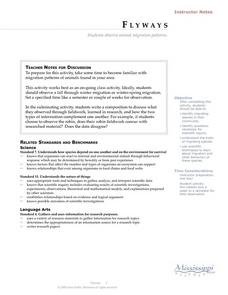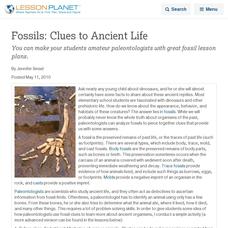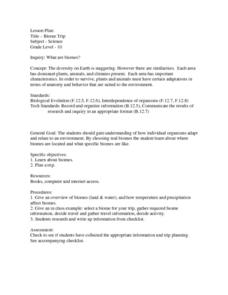Curated OER
Inference By Analogy
Students infer the use or meaning of items recovered from a North Carolina Native American site based on 17th-century European settlers' accounts and illustration.
Curated OER
Animal Migratory patterns
Students use field research and traditional research to identify migrating species of birds as well as their migratory patterns. Students generate a list of questions regarding migration and a plan to research the questions. A field...
Curated OER
Fossils: Clues to Ancient Life
You can make your students amateur paleontologists with great fossil lesson plans.
Curated OER
Wildlife Track Identification
Even though the PowerPoint slides for this lesson are not included, you may find it useful for the wildlife track preservation instructions provided. After demonstrating the steps for making track casts, take your class outdoors to make...
Curated OER
Enrichment Activities - "Mrs. Frisby and the Rats of NIMH"
Fifth graders read the novel "Mrs. Frisby and the Rats of NIMH." They discuss the various characters in the book, and the different types of conflict that take place within the book. They also research owls and rats to make comparisons...
Curated OER
"Julie of the Wolves"
Fifth graders research life in Alaska and compare life there to their lives in this instructional activity. They read "Julie of the Wolves." They research through the novel and other reference books facts about the Alaskan climate and...
Curated OER
Puerto Rican Parrot Paradise
Young scholars investigate the environment of the Puerto Rican Parrot. They visualize the ecosystem with and without information. They conduct research to find information and participate in classroom discussion to demonstrate...
Curated OER
The Excretory System
In this excretory system worksheet, students read a brief excerpt about water balance and the excretory system. Then they identify what compound birds, insects and reptiles living in dry habitats excrete. Students also describe how...
Curated OER
Seabird Survival Adaptation Card Game
Students study seabirds and how they have adapted to their environments. In this activity based instructional activity students will play a card game that will allow them to have a better understanding of seabirds and their adaptations.
Curated OER
The Basics: Life Science
Students develop an understanding of the different fields of study that are encompassed by the term, life science. They view and discuss a video on the topic. In small groups they focus on on of the examples shown in the video to create...
Curated OER
Hatching Chickens
Students explain the importance of carefully observing and caring for eggs and chickens in the classroom.
Curated OER
The Inside of an Apple
Students review the life cycle of apples before they study information about the inside of apples. They work in small groups to color and identify the parts of the inside of an apple. Finally, they use real apples to have an hands on...
Curated OER
Frog Metamorphosis
Students play 20 Questions with animal characteristics and then view an animation of how a tadpole changes into a frog. They consider the importance of camouflage to frogs and write out the story of a frog from tadpole to adult.
Curated OER
Holy Habitats or Meet Metamorphosis
Students examine the metamorphosis of frogs and how it adapts to its environment. They research how world pollutants are effecting the amphibian population.
Curated OER
Ecology 8 Land Biomes
High schoolers identify and describe the main features of one land biome. After researching what a biome is, they give various examples of biomes around the world and in their backyards.
Curated OER
Everything's Connected
Learners explore how trash decomposes. In this ecosystem lesson, students discuss new vocabulary words, such as producers and consumers, and think critically to answer how landfills work.
Curated OER
Using Description to Write in Science
Fifth graders use science process and thinking skills. They communicate effectively using science language and reasoning.
Curated OER
Footprint Detectives: Making Inferences Using Dinosaur Trackways
Students analyze and discuss footprints and dinosaur tracks. They listen to books about paleontologists, create and analyze their own trackways using black paper and chalk, examine the data, and form hypotheses about footprints and...
Curated OER
Coqui Frog Camouflage
Students investigate the concept of the coqui frog of Puerto Rico. They conduct research using a variety of resources. Students explain in oral or written form some of the characteristics to that identify the frog. The lesson includes...
Curated OER
Biome Trip
Tenth graders comprehed how individual organism adapt and relate to an environment. They investigate where biomes are located and what specific biomes are like. Pupils give examples of biomes (land and water), and how temperature and...
Curated OER
Picture Word Book
Students create a book. In this vocabulary and word identification lesson, students make a book by gluing pictures on construction paper, then the teacher writes words in the book to label each picture.
Curated OER
Picture-Go-Round
Students demonstrate how to participate in a cooperative group. In this philanthropy instructional activity, students create drawings by working together as a group and contributing their thoughts and feelings.
Curated OER
Honey Bee Biology
Students review the basic parts of an insect and explore the anatomical characteristics of a honey bee. The second part of the lesson focuses on ways to identify a honey bee from other stinging insects.

























